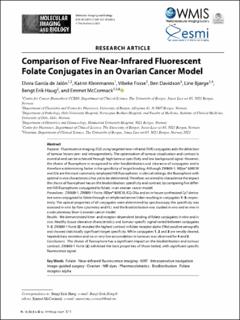| dc.contributor.author | García de Jalón, Elvira | |
| dc.contributor.author | Kleinmanns, Katrin | |
| dc.contributor.author | Fosse, Vibeke Samuelsen | |
| dc.contributor.author | Davidson, Ben | |
| dc.contributor.author | Bjørge, Line | |
| dc.contributor.author | Haug, Bengt Erik | |
| dc.contributor.author | McCormack, Emmet | |
| dc.date.accessioned | 2022-01-27T14:44:03Z | |
| dc.date.available | 2022-01-27T14:44:03Z | |
| dc.date.created | 2022-01-04T14:26:37Z | |
| dc.date.issued | 2021 | |
| dc.identifier.issn | 1536-1632 | |
| dc.identifier.uri | https://hdl.handle.net/11250/2893803 | |
| dc.description.abstract | Purpose
Fluorescence imaging (FLI) using targeted near-infrared (NIR) conjugates aids the detection of tumour lesions pre- and intraoperatively. The optimisation of tumour visualisation and contrast is essential and can be achieved through high tumour-specificity and low background signal. However, the choice of fluorophore is recognised to alter biodistribution and clearance of conjugates and is therefore a determining factor in the specificity of target binding. Although ZW800-1, IRDye® 800CW and ICG are the most commonly employed NIR fluorophores in clinical settings, the fluorophore with optimal in vivo characteristics has yet to be determined. Therefore, we aimed to characterise the impact the choice of fluorophore has on the biodistribution, specificity and contrast, by comparing five different NIR fluorophores conjugated to folate, in an ovarian cancer model.
Procedures
ZW800-1, ZW800-1 Forte, IRDye® 800CW, ICG-OSu and an in-house synthesised Cy7 derivative were conjugated to folate through an ethylenediamine linker resulting in conjugates 1–5, respectively. The optical properties of all conjugates were determined by spectroscopy, the specificity was assessed in vitro by flow cytometry and FLI, and the biodistribution was studied in vivo and ex vivo in a subcutaneous Skov-3 ovarian cancer model.
Results
We demonstrated time- and receptor-dependent binding of folate conjugates in vitro and in vivo. Healthy tissue clearance characteristics and tumour-specific signal varied between conjugates 1–5. ZW800-1 Forte (2) revealed the highest contrast in folate receptor alpha (FRα)-positive xenografts and showed statistically significant target specificity. While conjugates 1, 2 and 3 are renally cleared, hepatobiliary excretion and no or very low accumulation in tumours was observed for 4 and 5.
Conclusions
The choice of fluorophore has a significant impact on the biodistribution and tumour contrast. ZW800-1 Forte (2) exhibited the best properties of those tested, with significant specific fluorescence signal. | en_US |
| dc.language.iso | eng | en_US |
| dc.publisher | Springer | en_US |
| dc.rights | Navngivelse 4.0 Internasjonal | * |
| dc.rights.uri | http://creativecommons.org/licenses/by/4.0/deed.no | * |
| dc.title | Comparison of Five Near-Infrared Fluorescent Folate Conjugates in an Ovarian Cancer Model | en_US |
| dc.type | Journal article | en_US |
| dc.type | Peer reviewed | en_US |
| dc.description.version | publishedVersion | en_US |
| dc.rights.holder | Copyright The Author(s) 2021 | en_US |
| cristin.ispublished | true | |
| cristin.fulltext | original | |
| cristin.qualitycode | 1 | |
| dc.identifier.doi | 10.1007/s11307-021-01685-y | |
| dc.identifier.cristin | 1974467 | |
| dc.source.journal | Molecular Imaging and Biology | en_US |
| dc.relation.project | Helse Vest RHF: 911852 | en_US |
| dc.relation.project | Norges forskningsråd: 223250 | en_US |
| dc.relation.project | Helse Vest RHF: 912171 | en_US |
| dc.relation.project | Helse Vest RHF: 240222 | en_US |
| dc.relation.project | EC/H2020/675743 | en_US |
| dc.relation.project | Norges forskningsråd: 262652 | en_US |
| dc.relation.project | Kreftforeningen: 182735 | en_US |
| dc.relation.project | Norges forskningsråd: 226244 | en_US |
| dc.relation.project | Helse Vest RHF: 911809 | en_US |
| dc.identifier.citation | Molecular Imaging and Biology, 2021. | en_US |

